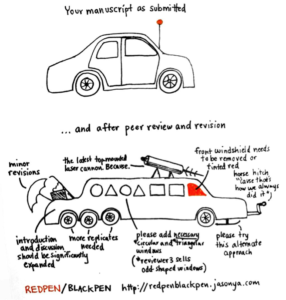DNA Classroom Activities
What is DNA?
This school group activity is aimed at students in grades 5-9. It is designed to take 60-90 minutes. It consists of five parts:
- A Day in the Ancient Biomolecules Laboratory Video
- Kitchen Genetics
- DNA Bracelets
- DNA Legos
- Dress Like a Scientist

Kitchen Genetics is an activity that involves students extracting DNA using common kitchen supplies. This activity requires a teacher to lead the activity. There is 1 handout for this activity. Most supplies for this activity can be purchased at an ordinary grocery store; 50 ml falcon tubes can be purchased online from any vendor.

DNA Bracelets is an activity that involves students stringing beads with letters to encode a short sequence of animal DNA in a bracelet. After a short demonstration, students can do this activity independently. There are 7 handouts for this activity. Each student should pick one of the handouts and make a corresponding bracelet. They may keep the bracelet. Here is a list of bracelet parts that you can order from a variety of online vendors, including Amazon.
- Horse DNA bracelet
- Cattle DNA bracelet
- Yak DNA bracelet
- Sheep DNA bracelet
- Goat DNA bracelet
- Reindeer DNA bracelet
- Camel DNA bracelet
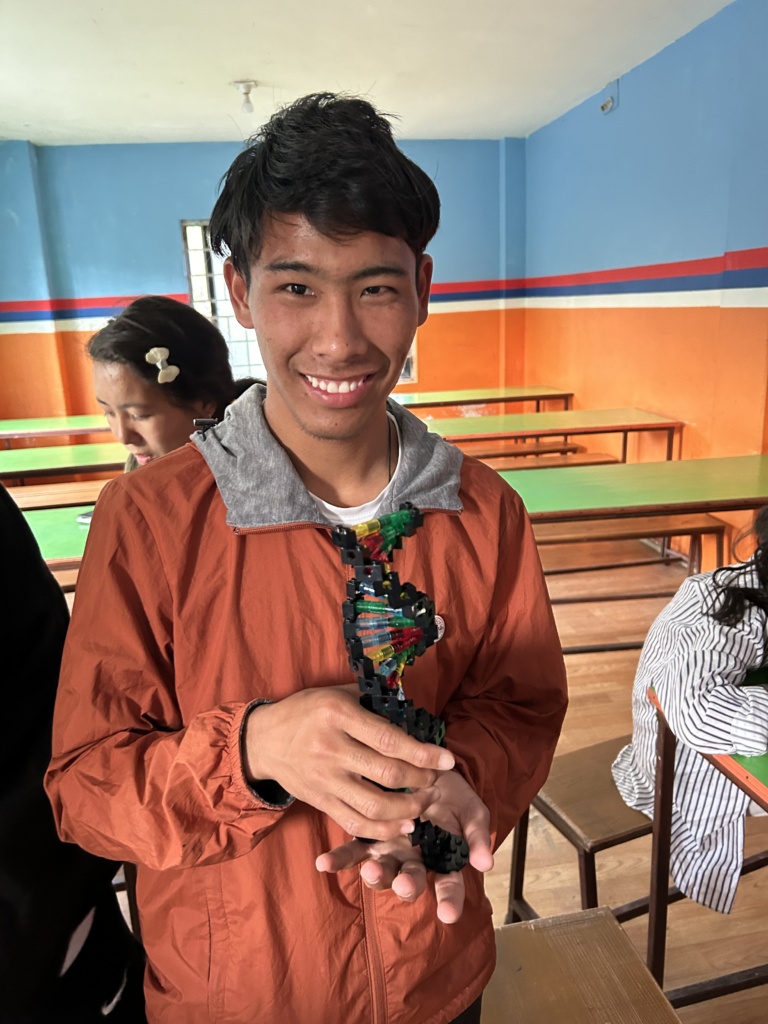
DNA legos is an activity that involves students working in pairs to build a DNA double helix using legos. After a short demonstration, students can do this activity independently. There is 1 handout for this activity. After completing the lego double helix, the students should return the legos so that another student may use them. Here is a lego parts list you can order directly from the online Lego Shop.
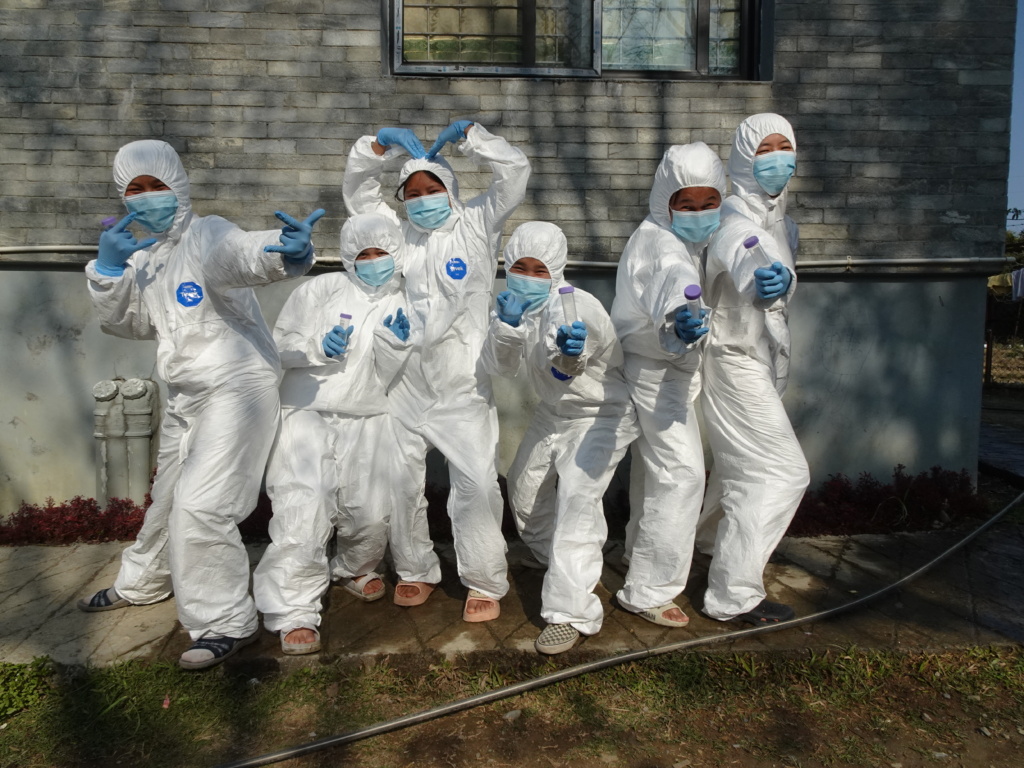
Dress like a scientist is an activity that involves students dressing up in the Tyvek suits, masks, and gloves worn by scientists when they study ancient DNA. Students may take turns trying on the scientist uniform and taking pictures with their phones. Students may want to pose with their extracted DNA, DNA bracelet, or DNA lego double helix for the photo. After a short demonstration, students can do this activity indendently. There is 1 handout for this activity. We recommend ordering a 5-pack of DuPont™ Tyvek® Coveralls with Hood, surgical masks with earloops, and nitrile gloves. Tyvek coveralls can be reused by all students in the class. Masks and gloves should not be reused.
Courses and Syllabi
Sick: 10,000 Years of Human Health and Disease
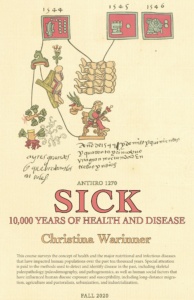
This course surveys the concept of health and the major nutritional and infectious diseases that have impacted human populations over the past ten thousand years. Special attention is paid to the methods used to detect and identify disease in the past, including skeletal paleopathology, paleodemography, and pathogenomics, as well as human social factors that have influenced human disease exposure and susceptibility, including long-distance migration, agriculture and pastoralism, urbanization, and industrialization.
Introduction to Archaeological Science
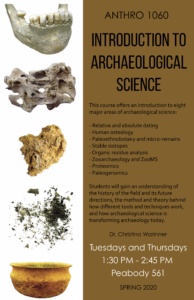
This course offers an introduction to eight major areas of archaeological science:
– Relative and absolute dating
– Human osteology
– Paleoethnobotany and micro-remains – Stable isotopes
– Organic residue analysis
– Zooarchaeology and ZooMS
– Proteomics
– Paleogenomics
Students will gain an understanding of the history of the field and its future directions, the method and theory behind how different tools and techniques work, and how archaeological science is transforming archaeology today.
Professionalization in Archaeology
All good research begins with a strong foundation. This course is aimed at providing you with the foundational knowledge and basic tools you need to succeed as a professional archaeologist. Aided in part by guest speakers from within and beyond Harvard, this course emphasizes collaborative research, presentation, publication, grant proposal writing, conflict resolution, and other skills to help you complete your PhD and to be competitive on the job market afterwards, and to navigate the complex intellectual, social, and personal demands of academia. The course structure focuses on five main themes: (1) getting organized and collaborating, (2) conferences and publishing, (3) proposal and grant writing, (4) when things go wrong, (5) preparing for the job market.
Human Diet: From Neanderthals to the Future of Food
This course surveys the evolution of human diet, from the foods of our earliest ancestors to the contents of today’s supermarkets. We’ll cover the definition of food, human nutritional requirements, major dietary transitions and food innovations in human history, the roots of world cuisine, the modern food industry, and current and future food challenges.
Anthropology of Microbes

Anthropology is the study of humans, but until recently anthropologists rarely considered the native microbes and viruses that inhabit our bodies – our microbiome. This is surprising because from a genetic perspective we are more than 99% microbial: our bacterial cells outnumber our human cells by at least 10:1, our bacterial genes outnumber our human genes by at least 150:1, and at least 8% of the human genome is actually viral. Our native microorganisms perform the essential functions of digesting our foods, making our vitamins, and educating our immune system; without this microbiome we would be at best sick and at worst dead. This graduate level course introduces the concept of humans as a composite organism – an ecological community of host cells, bacteria, archaea, and viruses. In this course we will shake up the tree of life and investigate how humans are more like a treehouse than a single branch. Specific topics to be covered include: the endosymbiotic theory of life, superorganisms and holobionts, human microbial variation, essential microbial roles in human digestion, immunity and emotion, diseases of dysbiosis, and the hygiene hypothesis. You will leave this course with a new anthropological understanding of our microbial self.
The course is divided into four parts that each focus on a different core concept relating to the microbiome. Part 1, Conceptualizing the Microbiome, focuses on fundamental biological concepts relating to the nature of life and the relationships between microorganisms and more complex organisms, like humans. Part 2, Investigating the Human Microbiome, explores how we study the human microbiome, including the funding sources and methodological tools at our disposal. This section also covers what we currently know the microbiome of major human body sites. Part 3, Evolution and Function of the Human Microbiome, focuses on the function of the human microbiome and how it varies through time and space. Major topics to be discussed include how the microbiome is transmitted between generations, how diet shapes the gut microbiome, and how the microbiome influences host immunity. Part 4, Complex and Emerging Topics on the Human Microbiome, explores complex and emerging topics on the human microbiome, including how the environment influences the microbiome, how disruptions of the microbiome influence health and disease, and how we are approaching a paradigm shift in how we view bacteria and antibiotics. Course syllabus and reading list.
Anthropology of Diet and Nutrition
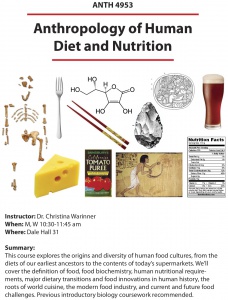
This undergraduate level course surveys the evolution of human diet, from the foods of our earliest ancestors to the contents of today’s supermarkets. We’ll cover the definition of food, human nutritional requirements, major dietary transitions and food innovations in human history, the roots of world cuisine, the modern food industry, and current and future food challenges. The course is divided into three parts that cover different aspects of human diet and nutrition. Part 1, The Biology of Food and Digestion, focuses on the biology basics of food, digestion, and nutrition. Part 2, The Evolution and Diversity of Human Diets, explores what we know about the evolution and history of human diets and how we know it. Part 3, Food Challenges and Controversies Today, focuses on controversial and complex topics relating to industrial agriculture, GMOs, government nutritional policies, dietary advice and guidelines, and other important topics at the forefront of domestic and international debates about the future of food.
This course aims to equip students with the knowledge, tools, and critical thinking skills necessary to understand and participate in global debates surrounding human nutritional health and the future of food. At the end of this course, students should be able to: (1) define food and explain how the human body digests and uses food; (2) describe what evidence anthropologists use to reconstruct past human diets; (3) explain current anthropological theories about the origins and evolution of human diets and critically evaluate popular fad diets; (4) describe the processes and consequences of domestication; (5) identify major food challenges and food controversies today and critically evaluate the contrasting viewpoints regarding the both the problems and the solutions. Course syllabus; Course reading list.
Introduction to Scientific Publication
Publishing the results of research studies in scientific, peer-reviewed journals is one of the pillars of academia. Successfully publishing in well-regarded journals has a strong impact on a researcher’s career, as publication record is often used as a key metric to evaluate the researcher’s academic merit. Beyond the research itself, the process of publishing scientific research typically includes a number of formalized steps, which include preparing a cover letter to the editor, writing a point-by-point response to reviewers, and correcting proofs. These steps are usually not the major focus of post-graduate education, but they are highly decisive about whether or not a research paper will be reviewed by a journal, and further accepted for publication. This course introduces these important steps of scientific publishing, discusses journal selection, manuscript preparation, and submission, and gives insights into how to publish successfully. Assignments covering each of these steps will enable early stage researchers to become trained and competent in the tasks related to scientific publishing in peer-reviewed journals. Course syllabus.
